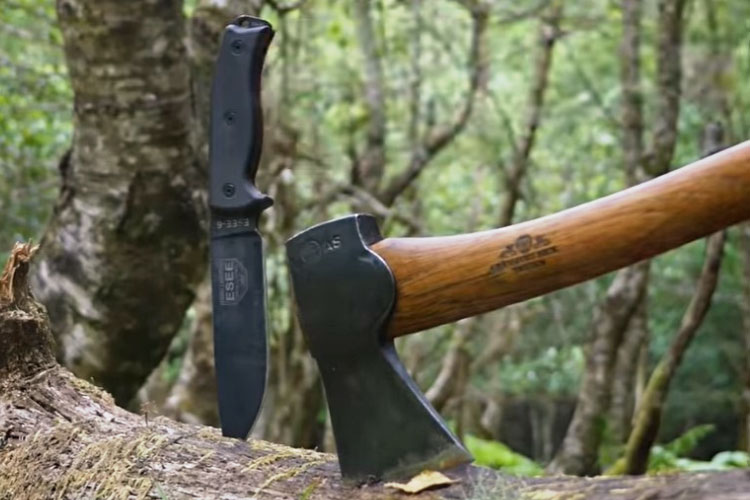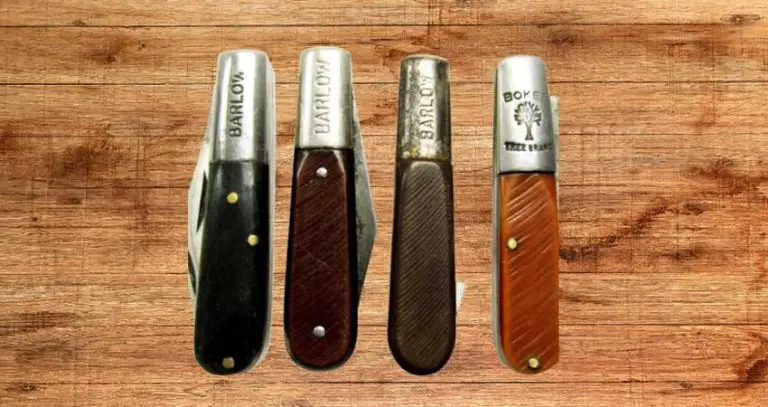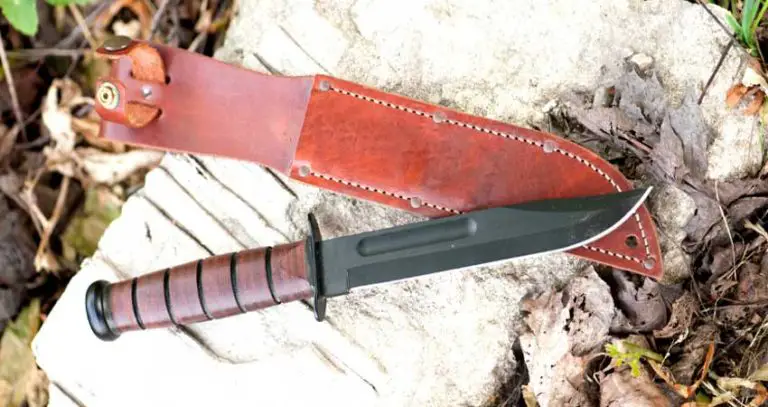Knife vs Axe: Which One To Choose?
An axe or knife can be the best tool to rely on for survival tools or outdoor activities. These versatile and practical tools are preferred for household activities too. But certain distinguishable features make these tools better suited for specific jobs.
So, knife vs axe, which one to choose? An axe is a heavy weighted tool with a big handle and sharp blade. This can perform heavy tasks like chopping and splitting wood. On the contrary, a knife is comparatively smaller, more versatile, and used for everything from food preparation to carving wood.
If you want to know more details on “knife vs axe” and which one to choose, keep reading till the end!
Knife Vs Axe: Comparison Table At A Glance
When it comes to choosing between an axe and a knife, there are a few certain particular features you have to keep in mind:

| Features | Axe | Knife |
|---|---|---|
| Blade | Made of metal (bit) and has a sharp toe, head and heel | Made of metal and sometimes plastic. Consists of point, spine, tip, edge, and heel |
| Weight | 1.5-2.5 pounds | 6.6-12.2 ounce |
| Handle | Made of synthetic materials and 18-36 inches long | Made of wood, plastics, etc, and 0.75- 1 inch ( shortest point) and 6.5-inches like in case of a machete or bigger knives ) |
| Activities | Heavy tasks | Light and heavy tasks |
Knife Vs Axe: In-Depth Comparison
Axe and knives have many essential and distinguishable features which are helpful to understand their jobs better. Some of the key differences between them are:
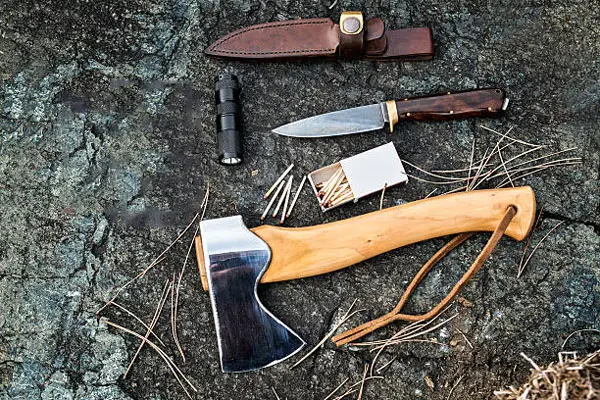
Blade
- Axe
The blade of an axe is made of metal, and it is also called a “bit.” There’s a cutting edge on the top corner of the “bit,” which is called “toe,” and the bottom corner is called “heel .”
An axe has two sides of a blade and the side of the blade is called the “cheek” and is amplified by “lugs”. This lug is the place where the head meets the handle.
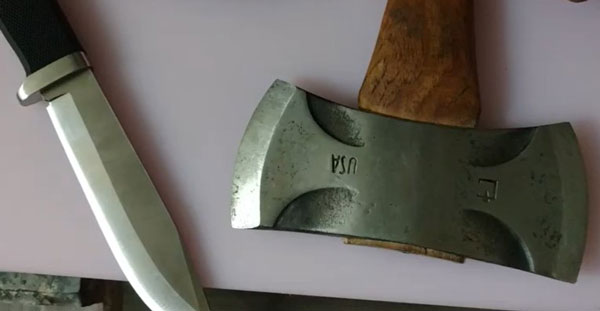
- Knife
The central part of a knife is the blade which consists of the point, spine, tip, edge, and heel.
There are mainly 4 types of blades in different knives which includes:
- Serrated Edge (Sharp grooves; cuts hard food)
- Straight Edge (Standard type)
- Hollow Ground Edge (Found in Japanese knives; very sharp)
- Scalloped Edge (Various dimples along the blade length)
Weight
- Axe
The weight of an axe varies depending on the size of the blade or haft, which overall makes the axe heavy. Heavy axes are efficient but too heavy can cause significant issues with cutting.
Generally, a hand axe can be 3.30 pounds, whereas a felling axe weighs 2-4 pounds. But on average, an axe should weigh 1.5-2.5 pounds for the most efficient use.
- Knife
The standard weight for an 8-inch chef knife is between 6.6-12.2 ounces, and the material of the blade affects the weight. Carbon blades weigh less than stainless steel ones of the same size.
Generally, a knife has a thin and narrow blade, which is better for slicing and detail work.

Handle
- Axe
“Haft” is another name for the handle of an axe. These handles are curved exquisitely for better cutting and swinging, and are often made of using long ash or hickory woods. The “shoulder” of an axe is where both the “head” and “haft” meet.
Mostly the length of the handle varies depending on the size and purpose of using a particular axe, but most handles are between 18 and 36 inches long.

- Knife
The handle of a knife is made up of mainly plastic, metal, sometimes wood, etc. Sometimes the handle is called “scales,” which can be grooved for better handling. A knife handle has four parts: the tang, rivets, butt, and bolster.
Likewise, the length of knife handles is between 0.75- 1 inch ( shortest point and it can extend to max 6.5 inches.)
Tasks
- Axe
Chopping Wood: The weight and long handle of an axe make it an ideal tool for chopping wood. And it can cut through large logs easily with less physical effort than a knife.
Splitting Wood: Axes are excellent for splitting wood as they have a wedge-shaped head, making it easy to split logs into smaller pieces for firewood or kindling.
Building Shelters: An axe can chop down trees and branches to build shelters and shape the woods effectively.
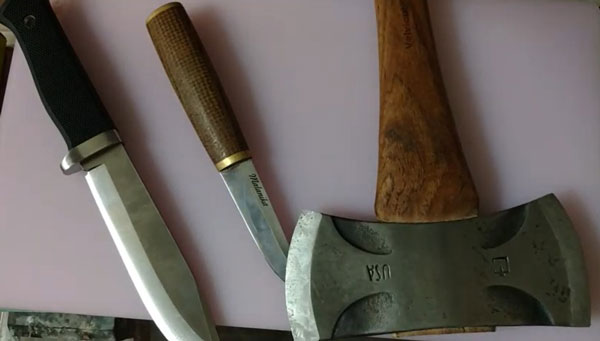
- Knife
Preparing Food: Knives are the go-to tool of all chefs for food preparation. Their small size and sharp edges chop vegetables, slice meat, and even fillet fish.
Carving Wood: Knives can be used for carving wood with sharp edges and precise control. To create intricate designs, knives are the best choice but they are less efficient in their work than an axe.
First Aid: A knife helps cut bandages or clothing to access wounds and perform other procedures, hence works as a part of a first aid kit.
FAQs
Here are some questions regarding the comparison of knives and axe that people often come across.
Q: Should I choose an axe or a knife for camping?
For camping, both axe and knives can be great tools. The axe can be used to chop wood for a bonfire, whereas a knife can be used to cut your meals and cook ingredients or cut small ropes.
Q: Which is better for self-defense, an axe or a knife?
For self-defense, it’s better to use strength rather than using any tool with sharp edges as it can seriously injure another party. However, if there’s no other way, a knife would be a better choice due to its small size and lightweight.
Q: Are both axe and knives equally dangerous?
Yes. Axe and knives can both be dangerous if not used properly. However, an axe can be more dangerous due to its heavy size and weight, hence can severely injure others than a knife.
Final Verdict
By far, you must have got an overall difference between “Knife Vs Axe” and which to choose for your work. The weight of the blade and handle of an axe makes it a heavy weighted tool for a heavy job such as – chopping or slicing wood.
On the other hand, knives are lightweight tools with sharp and fine blades and small handles for tasks mainly in the kitchen. So, depending on the task and its gravity, you must choose the best tool. Considering the abovementioned factors, you can select the best hand tool for your work now.

